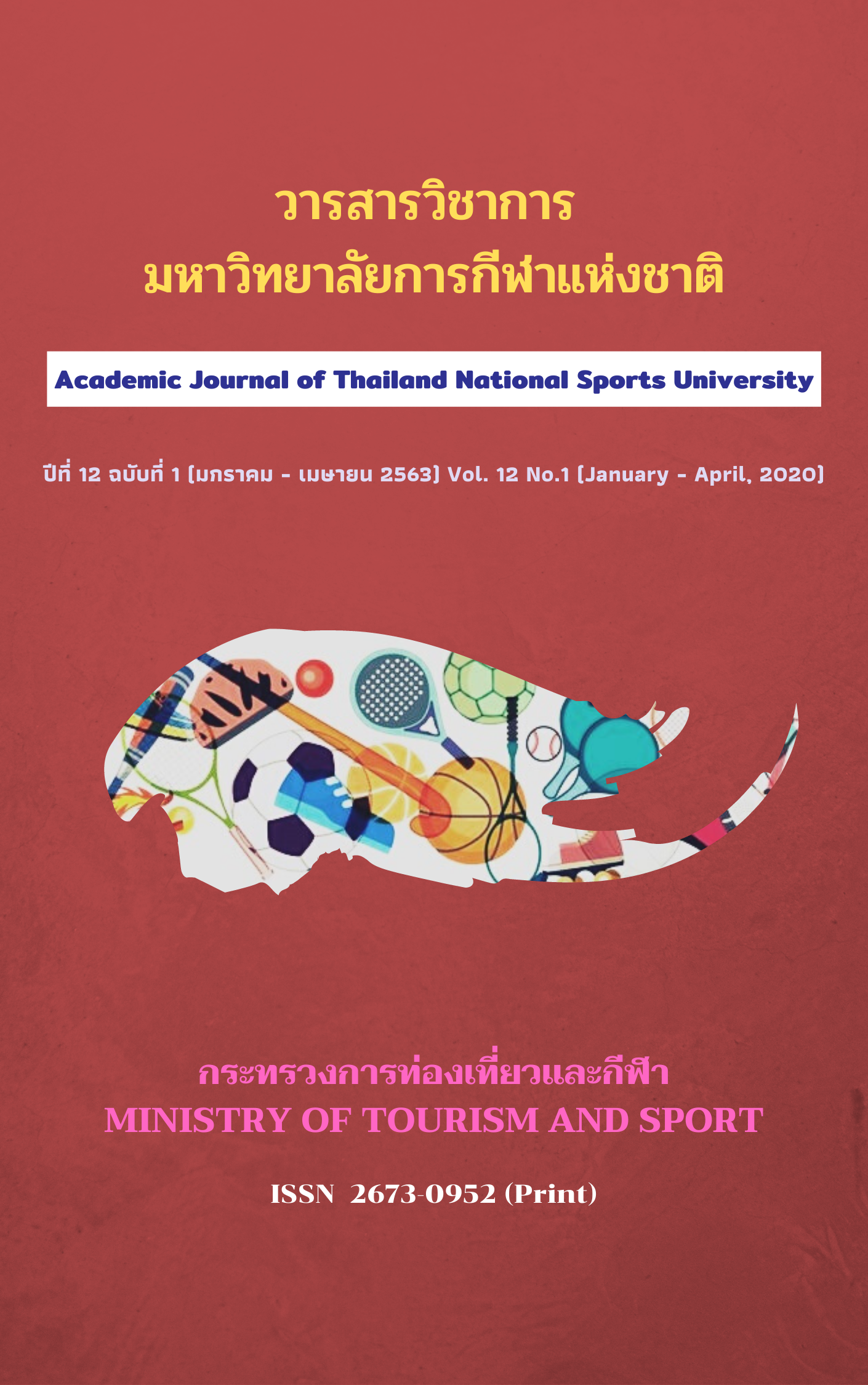AN EXPLORATORY FACTOR ANALYSIS OF THE MEASURE OF PHYSICAL AND PSYCHOLOGICAL STATES FOR SPORT INJURY IN THAI ATHLETES
Main Article Content
Abstract
The aim of current study was to examine the components of the physical and psychological states for sport injury in Thai athletes by using the Exploratory Factor Analysis Participants were 248 Thai athletes who got sport injured (male = 162, female = 86). Most of them aged between 18 – 21 years old, from 23 sports. Purposive sampling was used to particularly select the sport injured athletes to participate in this study. Equipment used in this study were 1) the warmth imagery program (Bhasavanija & Kuan, 2017), and 2) the Measure of Physical and Psychological States for Sport Injury. The Intraclass Correlation Cronbach’s Alpha reliability value was .811 and the apart-7-day test-retest reliability value was .695 analysed by using the Pearson’s Product Moment Correlation Coefficient. This measure was developed by the Measure of Physical and Psychological States in Sports: MPPSS, Bhasavanija, Cherathammawat, Chobthamasakul, & Poompin, 2014), consisting of five components and 18 factors (F): Quality of Life, Confidence, Anxiety, Perception of Pain, and Perception of Muscle Tension.
Results were component 1 consisted of six factors (F14, F18, F17, F15, F16, F13). Component weight value ranged from 0.60 to 0.81, and Eigen value was 4.38. This component was named the Perception, as Pain experienced now, Tension experienced during treatment, Tension experienced now, Pain experienced during treatment, Tension experienced during sport, and Pain experienced during sport.
Component 2 consisted of four factors (F9, F11, F12, F10). Component weight value ranged from 0.64 to 0.77, and Eigen value was 3.43. This component was named the Confidence, as Confidence in domination, Belief in performance, Belief in physical and mental capacities, and Confidence in competition.
Component 3 consisted of four factors (F1, F2, F4, F3). Component weight value ranged from 0.51 to 0.77, and Eigen value was 1.81. This component was named the Quality of Life, as being able to practice as usual, still living normally, retained motivation to practice, and still being team empathy.
Component 4 consisted of two factors (F7, F6). Component weight value ranged from 0.69 to 0.89, and Eigen value was 1.37. This component was named the Anxiety (mental), as Fear to be mistaking in a game, and Fear to be unable to play a game.
Component 5 consisted of two factors (F8, F5). Component weight value ranged from 0.49 to 0.66, and Eigen value was 1.04. This component was named the Anxiety (physical), as Neck pain, and sleeping trouble.
Article Details
The published article is a copyright of the Academic Journal of Thailand National Sports University. The passage appeared in each article in this academic journal is a perspective of each author which is not related to the journal. Each author is required to be responsible for all components of his/her own article. If there are any mistakes, each author must be responsible for those mistakes on his/her own.
References
Bell, R.J. & Thompson, C.L. (2007). Solution-focused guided imagery for a golfer experiencing the yips: A case study. Athletic Insight, 9(1), p.4.
Bhasavanija, T., Chirathamawat, P., Chobthamasakul, C., & Poompin. K. (2015). Validation of the physical and psychological state measure in sport for Thai athletes. Proceeding: The 2nd International Seminar in Exercise and Sport Psychology in Thailand. Burapha University, Thailand.
Bhasavanija, T., & Kuan, G. (2017). The effect of warmth imagery on physiological, physical and psychological states among injured youth sepaktakraw athletes: A case study design. International Journal of Sport, Exercise and Health Research, 1(1), 35-40.
Bhasavanija, T., & Morris, T. (2013). Using imagery of warmth in competition on oxygen consumption and golf performance enhancement. Proceedings: China International Congress in Sport Psychology. Beijing, China: ISSP.
Bhasavanija, T. & Morris, T. (2014). Imagery. In A.G. Papaioannou & Hackfort, D. Routledge Companion to sport and exercise psychology: Global perspectives and fundamental concepts. New York: Routledge.
Brewer, B.W., Cornelius, A.E., Van Raalte, J.L., Brickner, J.C., Sklar, J.H., Corsett, J.R. et al. (2004). Rehabilitation adherence and anterior cruciate ligament outcome. Psychology, Health, and Medicine, 9, 163-175.
Chamornman, U. (1992). Eduational research. Nonthaburi: Sukhothai Thammathirach University.
Chottidao, M., & Limroongreungrat, W. (2015). The study of Thai fencers injuries in 38th national sport competition at Trang. Retrieved June, 2017. from https://www.researchgate.net/publication/280545207.
Diaz, M.M., Bocanegra, O.L., Teixeira, R.R., Soares, S.S., & Espindola, F.S. (2012). Response of salivary markers of autonomic activity to elite competition. International Journal of Sports Medicine, 33(9), 763-768.
Hu, Z., & Li, J. (2015). The integration of EFA and CFA: One method of evaluating the construct validity. Global Journal of Human-Social Science: A Arts & Humanities – Psychology, 15(6) version 1.0.
Kemeny, K. (2003). The psychobiology of stress. Current Directions in Psychology Science, 12(4), 124-129.
Neuhauser, L., Disbrow, D., & Margen, S. (1995). Hunger and food insecurity in California. Technical Assistance Program Report. California Policy Seminar, University of California.
Moran, A.P. (2004). Sport and exercise psychology: A critical introduction. New York: Routledge.
Rae-Grant, A.D., Bethoux, F., & Fox, R.J. (2013). Multiple sclerosis and related disorders: Clinical guide to diagnosis medical management and rehabilitation. New York: Demos Medical Publishing.
Rohde, L.M., Bonder, B.R., & Triolo, R.J. (2012). Exploratory study of perceived quality of life with implanted standing neuroprostheses. Journal of Rehabilitation Res, 49(2), 265-278.
Ruiz, R., Legros, C., & Guell, A. (1990). Voice analysis to predict the psychological or physical state of a speaker. Aviat Space Environ Med, 61(3), 266-271.
Siepmann, M., Aykac, V., Unterdörfer, J.,Petrowski, K., & Mueck-Weymann, M. (2008). A pilot study on the effects of heart rate variability biofeedback in patients with depression and in healthy subjects. Applied Psychophysiological Biofeedback, 33(4), 195-201.
Smith, A.M., Adler, C.H., Crews, D., Wharen, R.E., Laskowski, E.R., Barnes, K., Bell, C.V., Pelz, D., Brennan, R.D., Smith, J., Sorenson, M.C., & Kaufman, K.R. (2003). The “Yips” in golf-A continuum between a focal dystonia and choking. Sports Medicine, 33(1), 13-31.
Sport Authority of Thailand. (2016). Sport Man Register. Retrieved from http://www2.sat.or.th/sportmanregis/sportRegis.asp.
Tirata Phasawanitch. (2016). PED4303 Sport Psychology. Bangkok: Ramkhamhaeng University Press.


